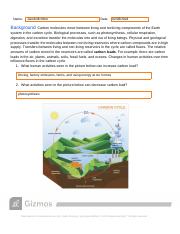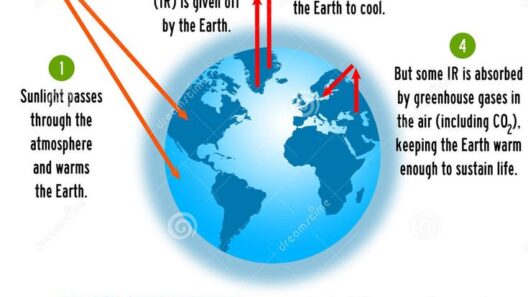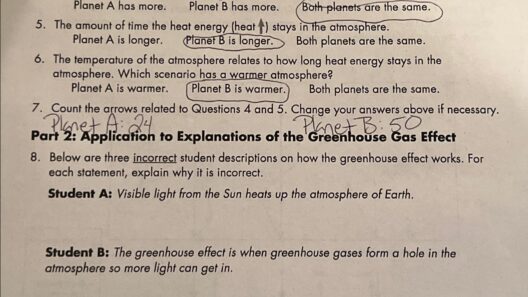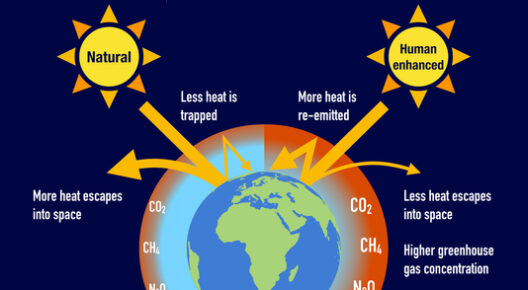Greenhouse gases play a pivotal role in determining the balance of our planet’s climate system. Understanding their impact on human life is crucial not only for environmental scientists but also for the average individual. This article delves into how greenhouse gases influence our daily lives and the global community at large.
When we talk about greenhouse gases, the most prevalent ones include carbon dioxide (CO2), methane (CH4), nitrous oxide (N2O), and fluorinated gases. Each of these gases originates from various sources, both natural and anthropogenic, and their accumulation in the atmosphere has far-reaching effects on health, agriculture, and economic stability.
The Unraveling of Our Climate
The Earth’s atmosphere necessitates a delicate equilibrium, and greenhouse gases contribute significantly to this balance. By trapping heat from the sun, they regulate our planet’s temperature—a phenomenon known as the greenhouse effect. However, an excess of these gases leads to excessive warming, causing climate change. The implications of this warming trend are catastrophic, impacting everything from weather patterns to sea levels, and ultimately, human well-being.
Extreme weather events such as hurricanes, droughts, and floods are becoming increasingly frequent and severe. Such volatile weather not only compromises physical infrastructures but also puts lives at risk. Communities that are ill-prepared for such calamities often bear the brunt, facing risks that could lead to fatalities and loss of property.
The Human Health Consequences
A salient aspect of the greenhouse gas dilemma is its intricate relationship with human health. Increased temperatures exacerbate air quality issues, primarily due to smog formation from pollutants. The World Health Organization attributes millions of premature deaths each year to air pollution, much of which originates from carbon emissions and their interactions with the local environment.
Moreover, changing weather patterns can trigger the spread of infectious diseases. Rising temperatures have been associated with the proliferation of disease-carrying vectors like mosquitoes, which can lead to outbreaks of diseases such as malaria and dengue fever. Thus, the very essence of human health is intertwined with the levels of greenhouse gases present in the atmosphere.
Furthermore, vulnerable populations—including children, the elderly, and those with pre-existing health conditions—are particularly susceptible to these detrimental health effects. Ensuring that all individuals have access to adequate healthcare resources becomes an urgent necessity in light of these escalating concerns.
Impact on Agriculture and Food Security
The repercussions of greenhouse gases extend into the agricultural sector as well. Climate change affects crop yields, soil quality, and the availability of freshwater—elements that are crucial for food production. As temperatures rise and rainfall patterns shift, certain crops may fail altogether, leading to food scarcity and escalating prices.
Farmers have to adapt to these changing conditions, implementing new technologies and approaches to contend with unsustainable practices. However, such adaptations may not always be economically feasible, especially for small-scale farmers. Hunger and malnutrition, particularly in developing countries, could spiral under these circumstances, leading to heightened poverty and social unrest.
The strategic importance of sustainable farming practices cannot be overstated. Regenerative agriculture advocates for practices like crop rotation and no-till farming, which can mitigate some of the impacts of climate change while also improving soil health. Implementing such measures on a large scale could be beneficial not only for food security but also for reducing greenhouse gas emissions from the agricultural sector.
Economic Dimensions
The persistence of greenhouse gases ultimately leads to economic ramifications that can be felt worldwide. Natural disasters, stemming from climate change, demand significant financial resources for recovery and rebuilding efforts. The infrastructure of nations—including transportation, healthcare, and housing—can experience immense strain from climate-induced events.
Moreover, global supply chains are increasingly at risk as climate-related disruptions become commonplace. Changes in production or natural resource availability may lead to economic instability, requiring nations to reassess their priorities and financial commitments. The resultant economic burden could result in a regression in human development indicators, setting back progress made over the last few decades.
Additionally, shifting to renewable energy sources presents both a challenge and an opportunity. Transitioning away from fossil fuels toward renewable energy technologies can yield significant reductions in greenhouse gas emissions, fostering economic growth in emerging sectors. Investments in clean energy infrastructure may thus serve as a catalyst for job creation, leading to more resilient economies.
Collective Responsibility and Action
Addressing the greenhouse gas crisis necessitates collective action at multiple levels—individual, community, corporate, and governmental. Public awareness and education campaigns can equip people with the knowledge needed to make sustainable choices in their daily lives. Simple actions—like reducing car travel, optimizing energy use at home, and choosing a plant-based diet—can collectively reduce emissions.
Real change, however, requires robust policy frameworks that mandate reductions in greenhouse gas emissions. Governments must invest in sustainable urban planning, support renewable energy projects, and incentivize businesses to adopt environmentally friendly practices. International cooperation is also indispensable, as climate change is a global problem that transcends borders.
In conclusion, the unfavorable impact of greenhouse gases on human life is multifaceted, affecting health, agriculture, and economic stability. Comprehensive approaches that include education, policy changes, and individual action are essential in mitigating these effects. Understanding and addressing these interconnected issues not only enhances our quality of life but also ensures a sustainable future for generations to come.








